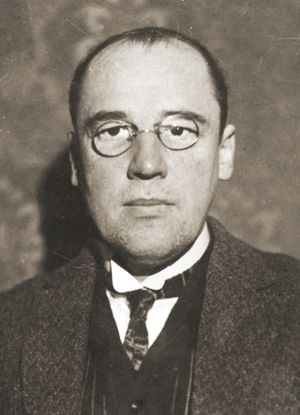Wacław Sierpiński facts for kids
Quick facts for kids
Wacław Sierpiński
|
|
|---|---|
 |
|
| Born |
Wacław Franciszek Sierpiński
14 March 1882 Warsaw, Congress Poland, Russian Empire
|
| Died | 21 October 1969 (aged 87) |
| Nationality | Polish |
| Alma mater | University of Warsaw |
| Known for | Sierpinski triangle Sierpinski carpet Sierpinski curve Sierpinski number Sierpiński cube Sierpiński's constant Sierpiński set Sierpiński game Sierpiński space |
| Scientific career | |
| Fields | Mathematics |
| Doctoral advisor | Stanisław Zaremba Georgy Voronoy |
| Doctoral students | Jerzy Browkin Edward Marczewski Stefan Mazurkiewicz Jerzy Neyman Stanisław Ruziewicz Andrzej Schinzel |
Wacław Franciszek Sierpiński (born March 14, 1882 – died October 21, 1969) was a famous Polish mathematician. He made many important discoveries in different areas of mathematics. These areas include set theory, number theory, the study of functions, and topology.
Sierpiński wrote over 700 research papers and 50 books. You might know his name from three cool fractal shapes. These are the Sierpiński triangle, the Sierpiński carpet, and the Sierpiński curve. There are also special Sierpiński numbers named after him.
Contents
Sierpiński's Early Life and Education
Wacław Sierpiński started studying at the University of Warsaw in 1899. He studied mathematics and physics there. In 1903, while still a student, he won a gold medal for an essay. This essay was about a topic in number theory.
He didn't want his work published in Russian, so he waited until 1907. It was then published in a Polish mathematics magazine. After graduating in 1904, Sierpiński worked as a teacher in Warsaw. He taught math and physics.
When his school closed due to a strike, he decided to get his doctorate. He went to the Jagiellonian University in Kraków. There, he learned from other great mathematicians. He also studied astronomy and philosophy. In 1908, he earned his doctorate degree. Soon after, he became a professor at the University of Lwów. By 1910, he was leading the math department there.
Sierpiński's Amazing Career in Math

In 1907, Sierpiński became very interested in set theory. This happened when he learned that points on a flat surface could be described with just one number. He was amazed and asked how this was possible. The answer he got was simple: "Cantor". Cantor was a mathematician who founded set theory.
Sierpiński then started to study set theory deeply. In 1909, he taught the very first university course dedicated only to set theory. He was a very busy researcher and writer. Between 1908 and 1914, he published three books. These books were about irrational numbers, set theory, and number theory. He also wrote many research papers during this time.
Working During World War I
When World War I began in 1914, Sierpiński and his family were in Russia. To stay safe as Polish foreigners, he spent the war years in Moscow. He worked with another mathematician named Nikolai Luzin. They started studying special kinds of sets together.
After the war ended in 1918, Sierpiński went back to Lwów. But soon, he was offered a job at the University of Warsaw. He took the job and became a full professor in 1919. He lived and worked in Warsaw for the rest of his life.
During the Polish–Soviet War (1919–1921), Sierpiński helped his country. He used his math skills to help break Soviet Russian secret codes. This was for the Polish army's code-breaking team.
Founding a Math Journal
In 1920, Sierpiński helped start a new math journal called Fundamenta Mathematicae. He started it with Zygmunt Janiszewski and his former student Stefan Mazurkiewicz. Sierpiński was the editor of this journal. It focused on papers about set theory.
During this time, Sierpiński mainly worked on set theory. He also studied point set topology and functions of real numbers. In set theory, he made important discoveries about the axiom of choice and the continuum hypothesis. These are big ideas about how numbers and sets behave. He also worked on the Sierpiński curve, which is a famous fractal.
Later Career and Retirement
Sierpiński retired in 1960 from the University of Warsaw. But he didn't stop working! He continued to lead a seminar on Number Theory until 1967. This was at the Polish Academy of Sciences. He also kept working as an editor for several math journals.
In 1964, he was one of the people who signed the "Letter of 34". This letter was sent to the Prime Minister of Poland. It was about the importance of freedom in culture. Wacław Sierpiński is buried at the Powązki Cemetery in Warsaw, Poland.
Awards and Honors Received
Wacław Sierpiński received many honors during his life. He was given honorary degrees from many universities around the world. These included universities in Lwów, Lima, Amsterdam, Sofia, Prague, Wrocław, Lucknow, and Moscow.
He was also elected to many important scientific groups. In 1921, he joined the Polish Academy of Learning. That same year, he became the dean of the math department at the University of Warsaw. In 1928, he became the vice-chairman of the Warsaw Scientific Society. He was also elected chairman of the Polish Mathematical Society.
Sierpiński was recognized by many international academies. These included groups in Lima, Liège, Bulgaria, Naples, Rome, Germany, the United States, Paris, the Netherlands, Brussels, London, and Romania. In 1949, he received Poland's Scientific Prize, which was a very high honor.
In 2014, a special sculpture was put up in Stockholm. It looked like a tree and was inspired by one of Sierpiński's fractals. This was part of an exhibition celebrating Poland joining the European Union.
See also
 In Spanish: Wacław Sierpiński para niños
In Spanish: Wacław Sierpiński para niños
- Arity theorem
- List of Polish mathematicians
- Menger sponge
- Seventeen or Bust
- The Sierpiński Moon crater
- Timeline of Polish science and technology
Images for kids


